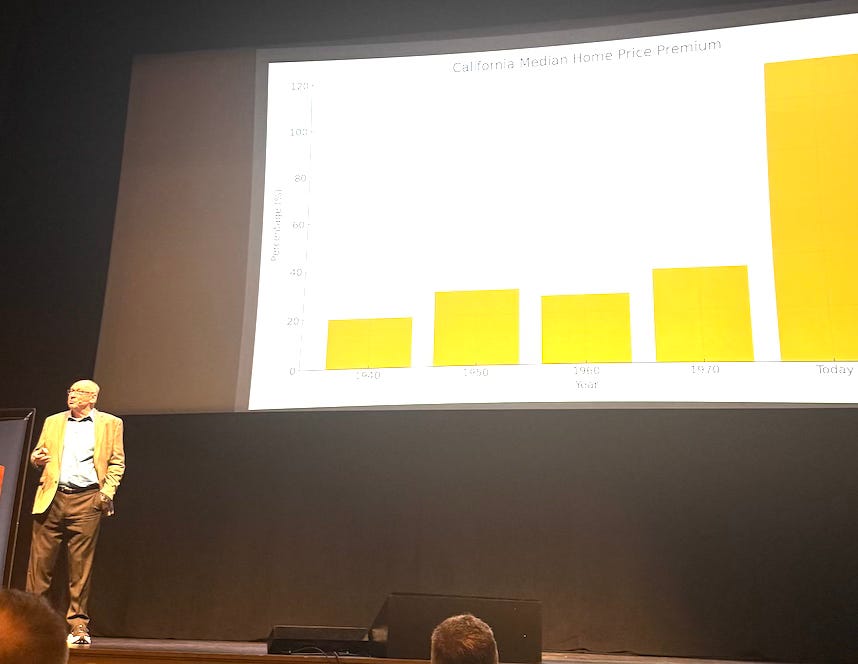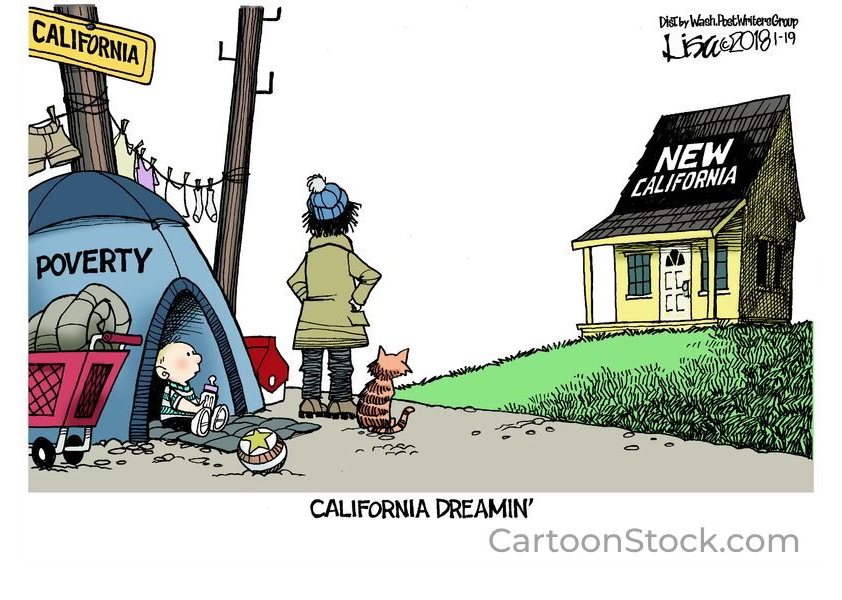Behind California’s Housing and Homelessness Fiasco
At the 44th Annual UCSB Economic Forecast Project in Santa Barbara, UCLA economics professor Lee Ohanian delivered a searing critique of California’s housing affordability and homelessness situation, exposing them as policy failures that betray the state’s promise.
The Golden State, once synonymous with opportunity, now prices out all but the wealthiest and abandons tens of thousands to the streets. Ohanian’s data is stark: a median home price of $884,000 (115% above the national average) is affordable to just 16% of households, per the California Association of Realtors. In Santa Barbara County, where the median home costs $1.4 million, affordability likely languishes between 8% and 12%. Homelessness has surged 60% since 2015 to 186,000—possibly 400,000 by some estimates—despite $37 billion spent since 2019.
These aren’t just numbers; they’re an indictment of a state failing its people.
Ohanian traced the housing crisis to a regulatory stranglehold that chokes development: the California Environmental Quality Act (CEQA). This bill was passed in 1970 after the 1969 Santa Barbara oil spill, and was meant to ensure environmental stewardship. But Ohanian illustrated how CEQA has become a weapon for obstruction. He cited Newhall Ranch, a proposed Valencia community for 60,000 people. Proposed in 1994, it took 27 years—until 2021—for the first homes to be built, mired in lawsuits and regulations that bankrupted developers. The result? Homes there now sell for up to $2.8 million. “Unless you reduce the cost of building, we cannot legitimately reduce the cost of California housing,” Ohanian told the UCSB audience.
This isn’t “inefficiency”; it’s economic sabotage.
A Little History
Ohanian’s historical data reveals that California once housed its booming population without such relative price premiums. From 1940 to 1970, the state’s population tripled from 7 million to 20 million, yet the median home price was only 28% above the national average. Today, with population growth at a mere 2%, the premium has skyrocketed over the last decade to 115%.

Q. Why?
A. Regulations.
Regulations have driven building costs in some California regions to double those in Arizona or Nevada. Sacramento’s response—over 100 new housing laws—has failed. Private building permits are down, and top-down mandates like the Regional Housing Needs Allocation (RHNA) force absurdities, such as Atherton, with a $7.8 million median home price, planning subsidized apartments for households earning over $200,000.
This isn’t progress; it’s policy theater.
The homelessness crisis, Ohanian argues, reflects mismanagement and misguided priorities. Despite $37 billion having been thrown at the problem, street encampments are rising. State and federal audits reveal billions unaccounted for, with inadequate oversight and little in the way of fraud safeguards. “There’s an awful lot of money where we just don’t know where it went,” Ohanian says, echoing the state auditor’s findings.
Policies such as “Housing First,” and “Harm Reduction,” which provide permanent housing without requiring sobriety or treatment, fail to address substance abuse and mental illness. San Francisco’s 3,462 overdose deaths in the past five years underscore the toll. Building apartments for the homeless at $1 million per unit—nearing the cost per square foot of Jeff Bezos’s Florida mansion—is not compassion; it’s fiscal insanity.

Ohanian’s solutions require – and demand – political courage, two things the state’s progressive Democrat supermajority have yet to muster. First, he says, reform CEQA to streamline environmental reviews without gutting protections. Second, prioritize development where land is affordable. Shafter, near Bakersfield, boasts a median home price of $370,000, less than half the state average. In Los Angeles, 33,000 vacant lots – many of them vacant for decades – could become homes especially if CEQA is amended. Third, embrace factory-built homes, which could cut costs by 50% to 70%, delivering housing for as little as $250,000 in less expensive regions, per Ohanian’s estimates.
More Ideas and Possible Solutions
At the reception after his presentation, I was able to drill down on more solutions with Professor Ohanian. For example, what to do about RHNA (Regional Housing Needs Allocation)? Solution: Allow housing requirements to become portable and traded among California cities. Cities like Atherton (the most expensive Zip code in the U.S.) and Santa Barbara (#5 most expensive) could meet their RHNA requirements by purchasing substantially lower priced housing in, say, Shafter. Rich Zip codes would be helping to develop poorer Zip codes much less expensively and without the ugly pack’em and stack’em developments (Sears anyone?) which diminish local charm and pressure delicate local infrastructure.
For homelessness, Ohanian urges reframing the approach as social insurance. Invest in treatment facilities over exorbitant housing, prioritize family reunification, and improve K-12 education—only 25% of California students are proficient in math. Policies must incentivize responsibility, not enable dependency. In Professor Ohanian’s own words “A free society demands contribution” not just a handout.
Sacramento’s pace is glacial, Ohanian notes. The attorney who navigated Newhall Ranch’s saga spends nearly every day in the Capitol, pleading for regulatory sanity. California can’t house everyone who dreams of its coast, but it can build smarter, spend wiser, and save lives. The alternative is a state where only the ultra-rich thrive, and the vulnerable languish.
Until California voters wake up and stop reelecting legions of deep-blue “Progressives” (including local enablers such as Gregg Hart, Monique Limon, and Laura Capps), the nightmare will only continue.
Take a look at COLAB’s latest video, “The Great Fee Heist”






Thank you, James, for the essay. "Hart, Limon & Capps"; let's include Carbajal and the entire City Council. This bunch elected by the ignorant voters who will not hesitate to approve a sales tax increase. It is simply astonishing!
Great article, James. The stranglehold of liberal politicians over the masses needs to be countered by a higher level of education which focuses on "creative problem solving," or a degree in CPS. CPS has little to do with math, but instead a lot to do with thinking about HOW to get out of the messes the city, state and federal government politicians have put us into. A CPS specialist would be a trained problem solver. Someone once mentioned to me that the main purpose of an education was to teach one how to think. It's "engineering" creative solutions to problems and knowing how to implement solutions that's important.